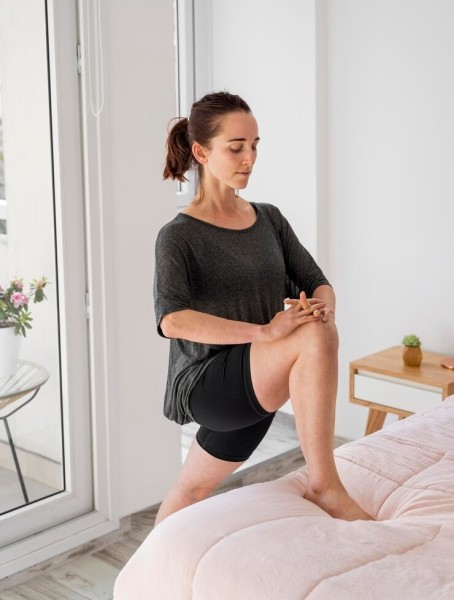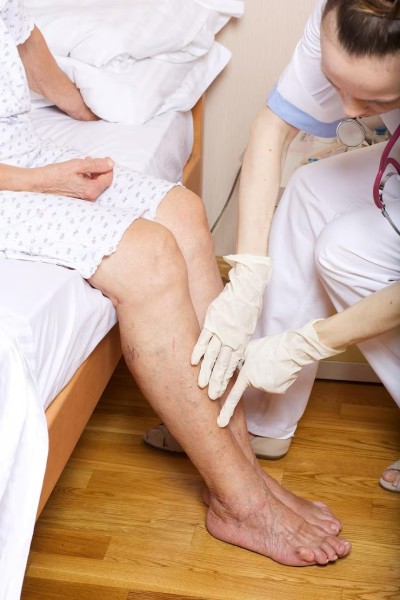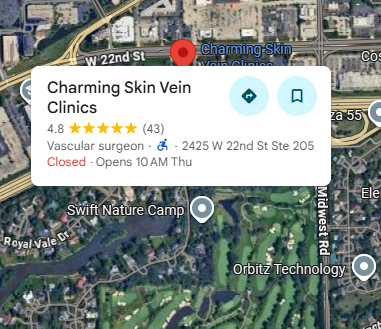Lifestyle Changes That Can Help Manage Varicose Veins
Varicose veins are not just a cosmetic issue—they indicate circulation problems that can cause leg discomfort, swelling, and fatigue. While medical treatment is available, simple lifestyle adjustments can help manage symptoms and prevent progression. Regular physical activity, maintaining a healthy weight, and following a balanced diet all promote better blood flow. Elevating your legs, staying hydrated, wearing compression garments, and choosing supportive footwear also play vital roles in reducing vein pressure and discomfort. Avoiding prolonged sitting or standing further supports healthy circulation. By combining these daily habits with professional care from Charming Skin Vein Clinics in Oak Brook, IL, individuals can effectively manage varicose veins and enjoy improved leg health and comfort.

Oak Brook, IL, United States, 22nd Oct 2025 – Varicose veins are more than just a cosmetic concern—they often signal underlying circulatory issues that can affect overall leg health. These enlarged, twisted veins commonly appear on the legs and can cause discomfort, swelling, and fatigue. While medical treatments are available, many individuals can benefit from adopting simple lifestyle changes to help manage varicose veins naturally. Incorporating regular movement, improving diet, maintaining a healthy weight, and wearing supportive footwear can make a significant difference in reducing symptoms and preventing progression. Understanding how daily habits affect circulation empowers you to take proactive steps toward healthier legs. With the right combination of mindful routines and professional guidance, living comfortably with varicose veins is possible. Let’s explore how everyday lifestyle choices can support better vein health.
Regular Physical Activity for Better Circulation
Consistent movement is one of the most beneficial lifestyle changes for managing varicose veins. Exercises that focus on leg movement—such as walking, swimming, and cycling—help stimulate blood flow and reduce pooling in the lower limbs. Regular physical activity strengthens the calf muscles, which act as a natural pump to push blood upward toward the heart. This reduces the strain on vein walls and valves, helping minimize swelling and discomfort. Even simple actions like standing up from your desk every hour or stretching throughout the day can support healthy circulation. It’s not about intense workouts; it’s about consistency and balance. Incorporating moderate exercise into your daily routine not only aids in managing varicose veins but also contributes to overall cardiovascular wellness and energy levels.
Maintaining a Healthy Weight to Reduce Pressure
Carrying excess weight places additional stress on your veins, particularly in the legs where blood must fight gravity to return to the heart. For individuals with varicose veins, this added pressure can worsen symptoms and increase vein visibility. Maintaining a healthy weight helps alleviate the burden on your circulatory system, improving blood flow and reducing discomfort. Focus on balanced nutrition with whole foods, lean proteins, and fiber-rich fruits and vegetables. Avoid highly processed foods high in sodium, which can cause fluid retention and swelling. Gradual, sustainable weight management through mindful eating and regular movement can make a noticeable difference in how varicose veins feel and look. Reducing pressure from excess weight is one of the simplest yet most powerful lifestyle steps for vein health.
Adopting a Balanced Diet for Vein Support
What you eat directly impacts your vein health and circulation. A balanced diet rich in antioxidants, vitamins C and E, and bioflavonoids helps strengthen blood vessel walls and improve elasticity. Fresh fruits like oranges, berries, and grapes are excellent choices, along with vegetables like spinach, broccoli, and bell peppers. Fiber-rich foods such as oats, legumes, and whole grains support digestive health, preventing constipation, which can increase abdominal pressure and worsen varicose veins. Additionally, staying hydrated keeps blood flowing smoothly and reduces the risk of swelling. Limiting salt intake helps prevent water retention and leg heaviness. Prioritizing nutrient-dense meals not only supports overall wellness but also promotes stronger, more resilient veins. A wholesome diet is a cornerstone in managing and preventing worsening of varicose veins.
Elevating Legs to Encourage Blood Flow
One simple yet highly beneficial habit for managing varicose veins is elevating your legs throughout the day. Raising your legs above heart level allows gravity to assist in blood flow back toward the heart, reducing pooling and swelling in the lower limbs. This position eases pressure on the veins and alleviates discomfort such as aching or heaviness. Incorporate leg elevation into your routine by lying down with your legs propped on a pillow or resting them on a chair for 15 to 20 minutes a few times a day. Elevating your legs after standing for long hours or following exercise can help relieve fatigue and promote circulation. Regularly practicing this habit supports overall vein health and complements other lifestyle efforts for managing varicose veins.
Wearing Comfortable Shoes and Avoiding High Heels
Footwear plays a significant role in leg and vein health. High heels, while stylish, can restrict proper calf muscle movement, which is essential for pumping blood back toward the heart. Over time, this may contribute to poor circulation and worsening varicose veins. Opt for supportive, comfortable shoes with low heels or cushioned soles that allow natural foot movement. Proper footwear helps distribute weight evenly and encourages better posture, reducing strain on your legs. If your daily routine requires standing or walking for extended periods, supportive shoes can significantly improve comfort and minimize swelling. Investing in the right footwear isn’t just about comfort—it’s a crucial step in managing and preventing further progression of varicose veins through improved circulation and stability.
Avoiding Prolonged Sitting or Standing
Staying in one position for extended periods—whether sitting at a desk or standing on your feet—can hinder circulation and worsen varicose veins. When blood pools in the lower legs, it increases pressure on the veins, leading to discomfort, swelling, and visible bulging. To counter this, incorporate movement breaks every 30 to 60 minutes. Simple activities like walking around, stretching, or flexing your ankles can help stimulate blood flow. If your job involves long hours of standing, shift your weight between legs and use supportive mats or footwear. When sitting, avoid crossing your legs and keep feet flat on the floor. These small adjustments reduce strain on your veins and make a noticeable difference in managing varicose veins symptoms over time.
Staying Hydrated for Healthy Circulation
Proper hydration plays a crucial role in maintaining healthy blood flow and reducing the discomfort associated with varicose veins. When the body lacks sufficient fluids, blood can become thicker, increasing pressure in the veins and making circulation less efficient. Drinking enough water throughout the day helps maintain optimal blood viscosity and prevents swelling caused by fluid retention. Hydration also supports skin elasticity, which is beneficial for the veins just beneath the surface. Aim for at least eight glasses of water daily, adjusting based on activity level and climate. Pair hydration with a diet low in sodium to further reduce bloating and heaviness in the legs. Keeping your body well-hydrated is a simple yet essential habit that supports overall vein health and comfort.

Using Compression Garments for Added Support
Compression stockings or socks can be an excellent addition to a lifestyle plan for managing varicose veins. These garments apply gentle, graduated pressure to the legs, helping push blood upward toward the heart and preventing pooling. They can reduce swelling, alleviate pain, and improve circulation, especially for individuals who stand or sit for long periods. Wearing compression garments regularly can also help slow the progression of existing varicose veins. Available in various styles and pressure levels, they can be fitted professionally for maximum comfort and effectiveness. Combined with other lifestyle changes such as movement, hydration, and leg elevation, compression wear offers valuable support in managing symptoms and promoting better vein health over time.
Conclusion
Managing varicose veins starts with intentional lifestyle choices that support better circulation, reduce pressure, and promote comfort. From daily exercise and balanced nutrition to proper hydration and supportive footwear, these habits can make a lasting difference in how your legs feel and function. However, if discomfort persists or your veins become more pronounced, it’s time to seek professional help. Charming Skin Vein Clinics in Oak Brook, IL, offers expert care and personalized treatments designed to restore your vein health and confidence. Don’t wait for symptoms to worsen—take the next step toward healthier legs today. Contact us at 630-974-2400 to schedule your consultation and begin your journey to lasting relief.
Business name: Charming Skin Vein Clinics
Address: 2425 W 22nd St Ste 205, Oak Brook, IL 60523, United States
Number: +16309741400
Website: https://www.charmingskin.com/
Company Details
Organization: Charming Skin Vein Clinics
Contact Person: Charming Skin Vein Clinics
Website: https://charmingskin.com/
Email: Send Email
Contact Number: +16309742400
Address: 2425 West 22nd Street #205
City: Oak Brook
State: IL
Country: United States
Release Id: 22102535870

